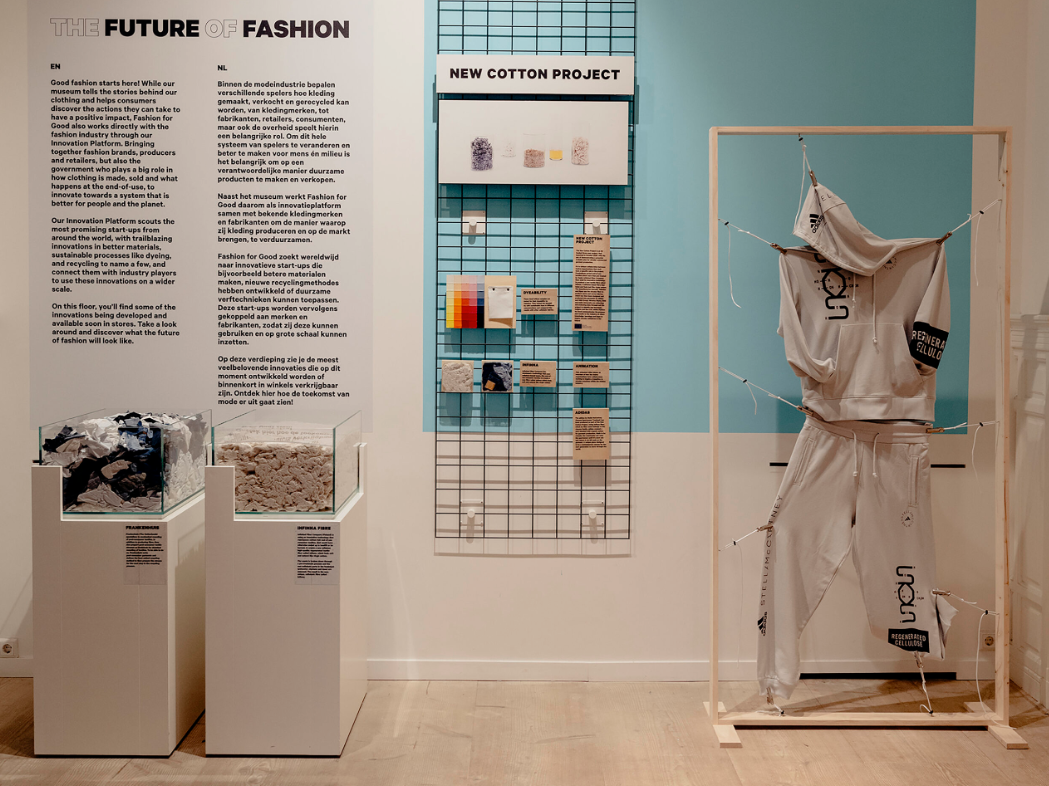
The EU-funded New Cotton Project marked an important milestone last week, with the launch of an installation charting its progress and processes at Amsterdam’s Fashion for Good Museum.
The installation celebrates the recent launch of the consortium’s first garments produced in collaboration with adidas and H&M Group. The collection is the first to be produced through the demonstration of a potential large-scale circular ecosystem.
Visitors can learn more about the consortium through a multi-media display, which includes details about the manufacturing process, an animation video explaining the workflows, a visual display of some of the garments and a documentary sharing the experience of the consortium through member’s voices.
The launch also coincides with the release of two additional white papers, produced by Aalto University as part of a series exploring circular business models. These papers are included in the installation, providing the audience with an overview of the New Cotton ecosystem blueprint and further insight into the consortium’s experience of demonstrating a potential circular ecosystem within the EU textile industry.
The launch of the garments and installation mark the two-year point of the three-year project. The final stage of the collaboration will focus on continued data collection, further academic papers from Aalto University and the Life Cycle Assessment. All of which will be shared with the wider industry with the aim of inspiring further circular initiatives in the future.
Current data suggests that up to a quarter of European post-consumer textiles could become textile-to-textile recycling feedstocks in the future. This includes the 494,000 tonnes of low-value post-consumer textiles, identified in the recent Fashion for Good’s 2022 ‘Sorting for Circularity Europe Project Report’, as readily available for fibre-to-fibre recycling.
An estimate of how much is likely to be a fit for Infinna™ technology will be available later on in the project. Illustrating the journey of the New Cotton Project for a public audience, the new installation charts the processes and progress of the consortium in the run up to the release of the garments.
According to the ‘Sorting for Circularity’ report, it’s estimated that only 2% of post-consumer textiles are diverted to fibre-to-fibre recycling.
The fashion industry urgently needs scalable solutions, yet the creation of circular materials to decrease dependency on virgin material has historically proven challenging, with a truckload of textiles being sent to landfill or burned every second. There have been many pilot schemes, but no organisation has been able to address the problem alone.
Led by Infinited Fiber Company, the New Cotton Project was launched in response to this challenge. Bringing together key players in the circular ecosystem, with an aim to demonstrate a potential blueprint for commercial circular garment production, and a new, more sustainable way of working for the fashion industry.
Therefore, the adidas by Stella McCartney (Gender Neutral) Sportswear Tracksuit Viscose, and H&M Group’s utilitarian jacket and trousers, are more than just beautiful pieces of clothing made using high-quality Infinna™ fibre, created from post-consumer end-of-use textiles: They’re a demonstration of the potential of a circular garment ecosystem that highlights the industry’s ability to move from a linear to a circular model of production.
Dig Deeper.
- Learn more about H&M’s sustainability initiatives.
- Check out the adidas Made to be Remade project.
- Discover Infinna™.
- Read all kinds of good news from Infinited Fiber Company on our news page.